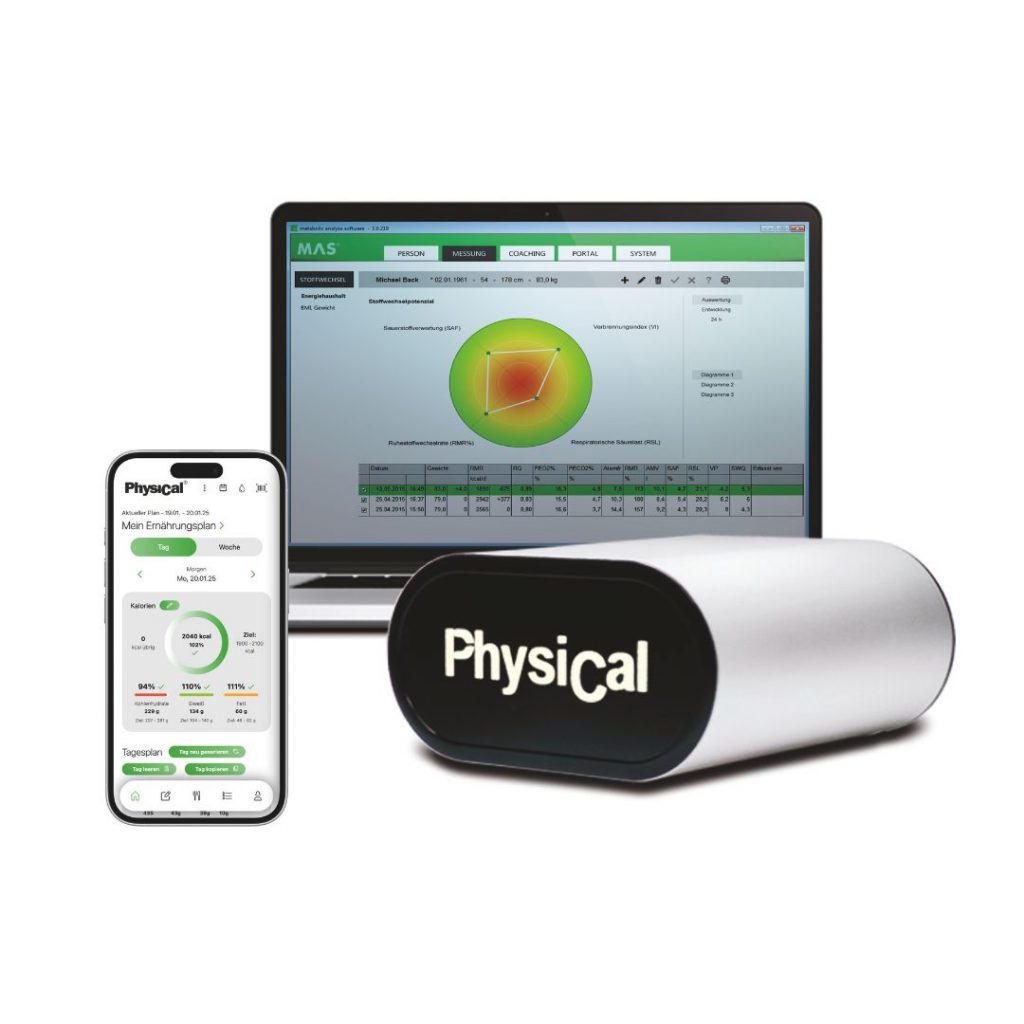PhysiCal® technology:
Measure. Understand. Change.
Measure in 5 minutes why your body stores fat - and how to burn it from today
Ready to decode your metabolism?






Ergebnisse & Fazit
Detailed metabolic measurement procedure with the PhysiCal®
The resting energy turnover is the turnover during mental and physical rest and is approx. 10-15% higher than the basal metabolic rate. Furthermore, no food should be consumed three to four hours before the measurement so that food-induced thermogenesis has no influence on the result. This indicates the proportion of the energy turnover that has to be used for digestion, absorption and storage. Work-induced thermogenesis is characterized by all physical activity.
To illustrate this, the percentages of 24-hour energy expenditure are broken down as follows: Resting energy expenditure accounts for approx. 60-70%, food-induced thermogenesis for approx. 5-10% and work-induced thermogenesis for approx. 20-30% of the 24-h energy expenditure.
The following data is determined in the metabolic analysis
Important metabolic measurement data are
VCO2 Carbon dioxide output (l/min)
VO2 oxygen uptake (l/min)
RER respiratory exchange rate (CO2 release/O2 uptake in the lungs)
RQ respiratory quotient (CO2 release/O2 uptake at the mitochondrion)
REE resting energy expenditure (Ruheenergieumsatz)
Findings from metabolic measurement with the PhysiCal®
Resting Metabolic Index The ratio of the oxygen (O2) you inhale to the carbon dioxide (CO2) you exhale is described by the Resting Metabolic Index (RMI). This shows you how well your metabolism is prepared for successful weight loss, for example.
Resting metabolic rate (RMR%) The resting metabolic rate (RMR %) shows the body's ability to deal effectively with the uptake of oxygen and nutrients, their chemical conversion and the release of metabolic end products. The aim is to achieve a balance between too low and too high metabolic activity.
Resting metabolic rate The resting metabolic rate indicates the energy consumption at rest. It is the energy that the body needs per day at rest to maintain its functions.
Fat calorie percentage The fat calorie percentage is the energy from the resting metabolic rate that is consumed in the form of free fatty acids.
Fat burning The value of fat burning indicates how well energy (ATP) can be generated from the supplied and stored fats. The better your fat metabolism functions under resting conditions, the more favorable the conditions for effective weight adjustment.
Sugar consumption This value indicates the proportion of energy production via glucose. This takes place when sugar is consumed through food, which the organism converts into energy (ATP). Less oxygen is absorbed through the lungs. When glucose is converted into energy (ATP), water and carbon dioxide are released. The carbon dioxide and oxygen are measured using special sensors.
Respiratory rate The respiratory rate indicates the number of breaths within one minute. Adults normally breathe between 10 and 15 times per minute, children slightly more (up to approx. 25 times per minute).
Tidal volume The tidal volume is the amount of air that is inhaled or exhaled per breath. The amount of air exhaled is measured by the volume flow sensor. Like the respiratory rate, this value depends on the metabolic conditions. The tidal volume at rest is approx. 0.5 liters. To adjust the tidal volume to the body weight, you can calculate with 6-8 ml/kg body weight. If the body is working harder, more oxygen is required by the cells. In order to meet the increased demand, the body increases not only the respiratory rate but also the tidal volume.
Oxygen utilization The inhaled oxygen can only be utilized to a limited extent. The rest is exhaled again when you breathe out. The better the organism can absorb oxygen, the more energy (ATP) the cells' power plants can generate from fats.
Respiratory acid load The amount of carbon dioxide (CO2) produced during energy metabolism and measured in the exhaled air allows conclusions to be drawn about the acid load. A permanently high acid load makes fat burning and the associated weight adjustment more difficult.
Breathing time volume/breathing minute volume The breathing time volume is the volume of air that is inhaled and exhaled in a certain period of time. The respiratory minute volume is measured in a period of one minute. The respiratory minute volume at rest is approx. 6-10 liters.
Metabolic potential The metabolic potential compiles the interplay of oxygen utilization, acid load, energy utilization and the caloric portion of fat burning in a sophisticated evaluation system. In addition to the allocation of metabolic points, a quickly comprehensible visual assessment is provided.
Interested in a personal consultation about PhysiCal® ?

-
Optimized metabolic efficiency
The PhysiCal® precisely analyzes your individual metabolic state and shows how efficiently your body burns fat, which leads to targeted weight regulation and noticeably more energy in everyday life.
-
Simple and fast measurement
The PhysiCal®- measurement is completed in just 5 minutes, with no time-consuming preparations or invasive procedures - perfect for people with busy schedules and a wide range of health goals.
-
Scientifically precise
The PhysiCal® technology is based on proven respiratory gas analysis (spirometry) with a measurement accuracy of over 98%, which guarantees reliable results and well-founded recommendations for your metabolic success.

Additionally, this site is NOT endorsed by facebook in any way.
FACEBOOK is a trademark of FACEBOOK, Inc.
Deutsche Gesellschaft für
Ernährung und Sport
Bahnhofstr. 52A
D-83620 Feldkirchen-Westerham
Copyright 2025 – dg-es.de
